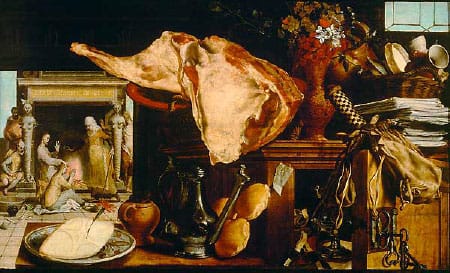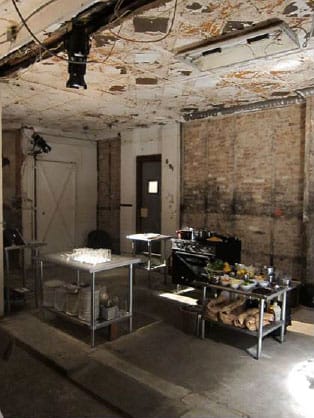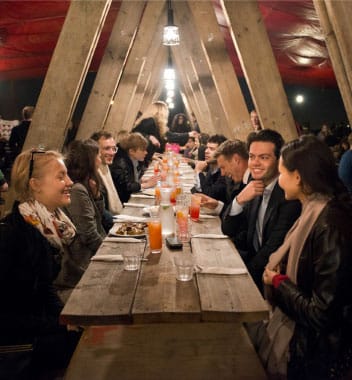The relationship between art and food is an old one, it could in fact be argued that the very first representational art had food as its subject, a large number of cave paintings depicting those animals hunted by humans. Yet as the relationship has evolved, from representations of food to cooking as the structure of an artistic production and finally to food itself as art, the balance between the two has shifted. In a society increasingly focused on service and experience, food is beginning to eclipse artistic practice in the traditional sites of their conjunction. The issue of exclusivity for both artist and audiences that this raises leaves a bitter taste in the mouth.
This history of the modern relationship between food and art lies in the Dutch still life. In the sixteenth century the Dutch Reformed Protestant Church banned the creation of religious imagery and so patronage of the arts moved to the mercantile middle class. Paintings which were to be sold after completion, rather than being commissioned, needed to depict subjects which would appeal to this audience and so images of food, a passion of this newly wealthy strata, came to the fore. Especially popular were the Vanitas in which luxurious produce and ingredients were portrayed, tempered by the beginnings of rotting and decay: A pious reminder of the temporality of material things and an admonition against gluttony. It is this mix of the representation of every day life and a moral, holistic message which has continued to shape the modern relationship between food and art.
Food continued as the subject of art throughout the evolution of formal movements, serving to open the horizons of its gaze and appreciation. Food also became an object of art in Surrealist exhibition, Fluxus performance, Relational installation and beyond in which the material of art became democratised, a reflection of a quotidian consumption. In most iterations food and cooking have been brought in to public or institutional spaces to erode the distinctions between them and between the artist and audience. Works by artists such as Rikrit Tiravanija, Jennifer Rubell or AO& provide more or less complex interaction with ingredients, cooking and food culture which contain within them the kernel established in the Dutch Vanitas: The representation or celebration of everyday life, often the simple act of cooking and a moral charge, the theological register replaced and updated by a 'political' creation of a communal consumption or critique. At their worst these works create a kind of 'foodie' temporary autonomous zone, the critique of which is both numerous and well documented. Whilst it is not worth revisiting it at length here, it would suffice to say that these works are often only democratic in the most simplistic of ways and often served only existing, privileged communities: A point made succinctly by Claire Bishop: For Relational Aesthetics ‘What Tiravanija cooks, how and for whom, are less important... than the fact that he gives away the results of his cooking for free.’
This type of artwork has become passé since its heyday in the 1990s, overshadowed by the turn towards more research based and networked projects of more problematised participatory art. However the mantel of this convivial food/art synthesis has been taken up by galleries and museums and its effect on institutions has been profound and remains extremely relevant. Today no institution which hopes to be culturally relevant can do without at least a café and preferably a restaurant and cocktail bar. Specifically in London, recent revamps of both the South London Gallery and Whitechapel Gallery have included café/restaurants. In Peckham the annual sculpture show Bold Tendencies has been somewhat overshadowed by the word-of-mouth success of its attendant bar/restaurant, Frank's.
It is this last situation however which best highlights the current asymmetrical symbiosis of food and art. As relational and participatory art sought to break down the barriers between artist and audience, with spectators not merely completing work but producing it, cafés bars and restaurants can increasingly fulfil the role of artworks. Providing an experiential involvement for participants, they create much the same communities of like-minded individuals with all the same problems. A meal at a gallery's restaurant, created by a chef-as-artist, gives the impression of unmediated access to an undefined, yet 'authentic', artistic community: The meal-as-artwork represents a wealth of shared cultural capital. Following convention this also contains its own moral caveat simply provided here by the responsibly sourced, organic and artisan produce. Any lingering doubts over the justification for such consumption are soothed by talk of animal husbandry, food miles and traditional processes.
With the chef playing the role of artist-genius and the authenticity of the ingredients offsetting a fear of gluttony, food provides the unifying and exclusive experience of the participatory art work. However it is able to negate artworks themselves as it is couched in the lucrative framework of authorship and authenticity that contemporary artists are at pains to jettison. Returning once again to the Vanitas this situation has been brought about by issues of patronage and audience: Whilst food and drink have become essential facets of publicly funded institutions this is not merely the result of fashion but, in an era of diminishing state funding for the arts, it provides much needed additional revenue. The problem, as with any privatisation, is that of exclusivity. Even if art isn't going to be completely supplanted by food and drink, it undoubtedly now exists alongside and so it must be asked if the culture created is socially and economically exclusive.
The chef Ferran Adria, whose restaurant was five times voted best in the world and who was an invited participant at Documenta 12 is currently the subject of a 'retrospective' in Somerset House. The exhibition will show plans, photographs and models of dishes he created alongside footage from his former restaurant El Bulli. Yet to experience Adria's art is surely to eat his food, which required access to his ultra-exclusive Catalan restaurant, and so this art is open to the same criticisms levelled at Relational Aesthetics. Access to art here is filtered by an invite to an event during a private view, or a seat at a table at an extremely expensive restaurant. When the rest are left with detritus and documentary material a two tier system of participation is created, where grades of consumption are opened by affluence and initiation. Here the roles of food and art within the Dutch Still Life are reversed: Food is now the representing medium, whilst art provides the symbolism of wealth, both cultural and economic, which remains the basis for production.
Robert Prouse

Pieter Aertsen, Vanitas Still Life, 1552 (Kunsthistorisches Museum, Vienna)

AO& with John Gerrard, New York residency , Simon Preston Gallery, 2010 (AOund.net)

Frank's Café, Bold Tendencies, Peckham (http://www.tate.org.uk/)

elBulli: Art of Food, Somerset House, 2013 (Gizmodo.co.uk)